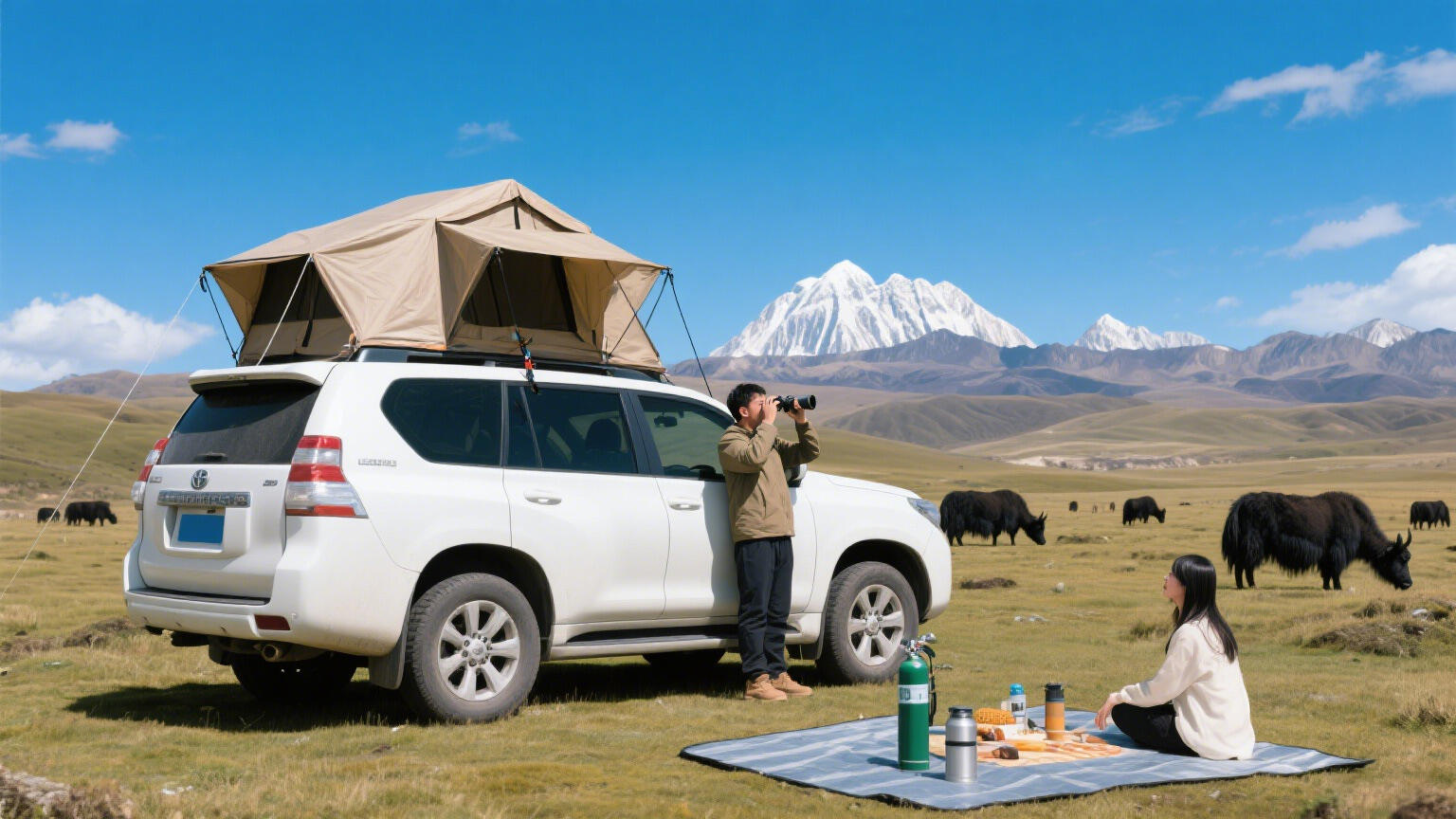Rooftop Tent Performance on Off-Road and Rugged Terrain
How a Rooftop Tent Handles Rugged Trails and Uneven Ground
Today's rooftop tents are built tough enough for rough terrain thanks to strong aluminum frames and adaptable mounting setups. According to research published in 2023 by the Ponemon Institute, cars equipped with these rooftop models kept about 92% of their normal stability when tackling rocky trails, while standard ground tents only managed around 76%. The secret lies in those pivot points that let the tent move side to side about 15 to 20 degrees. This flexibility helps soak up impacts from uneven surfaces and obstacles without breaking anything. Campers who frequently hit unpaved roads will appreciate how this design keeps things secure even when conditions get rough.
Suspension Stress and Vehicle Stability with a Rooftop Tent During Off-Roading
When someone installs a rooftop tent weighing between 150 and 250 pounds, it actually lifts the car's center of gravity higher off the ground. According to tests done by SAE International, this simple addition increases the chance of rolling over by about 18% when driving up hills at around 30 degrees. But wait! There are ways to cut down on those dangers. Upgrading to better shocks called monotube models helps stabilize things quite a bit. Also keeping tires slightly underinflated by maybe 3 or 4 psi compared to what's recommended for highways gives better grip on rough roads. And don't forget to slow way down too – staying under 15 miles per hour makes all the difference when tackling tricky mountain trails or rocky paths.
Best Practices for Securing a Rooftop Tent on Bumpy Terrain
- Pre-Trip Inspection: Torque all mounting bolts to 35–40 Nm using a calibrated wrench
- Load Distribution: Keep heavy gear low in the vehicle to minimize top-heaviness
- Anchor Reinforcement: Use secondary safety straps rated above 500 lbs
- Post-Drive Maintenance: Clear debris from ladder rails and hinge mechanisms
Field tests confirm these practices reduce equipment failure by 63% on washboard roads and steep descents.
Durability of a Rooftop Tent in Extreme Desert Conditions
Rooftop tents these days handle brutal desert conditions pretty well thanks to special fabrics that fight off UV damage and built-in cooling systems. Take 300D poly-cotton for instance it blocks nearly all those harmful UV rays according to recent industry reports from 2023. And when temps start climbing past 110 degrees Fahrenheit, the mesh panels let air circulate without totally compromising protection. The really fancy models come with reflective coatings too, which can actually make the inside feel 15 to 20 degrees cooler than regular tents. Makes sense why campers in hot climates are increasingly reaching for these upgraded options.
Impact of Sand Exposure on Rooftop Tent Zippers, Fabrics, and Mechanisms
Fine desert sand poses specific threats to tent components:
- Zippers: Self-cleaning YKK zippers with silicone seals reduce grit-induced jamming by 73% in sandstorm simulations
- Fabrics: 300D polyester blends exhibit 40% less abrasion damage than cotton-canvas after 200 hours of sand exposure
- Hinges/Latches: Aluminum parts with PTFE coatings resist corrosion 2.5x longer than untreated steel
These enhancements significantly extend service life in abrasive environments.
Growing Trend of Rooftop Tent Use in Southwest U.S. Desert Adventures
According to the latest Outdoor Industry Report from 2023, around 85 percent of overlanders who responded to surveys have switched to using rooftop tents when heading out on those long desert adventures through places like the Mojave and Sonoran Deserts. Why? Because manufacturers have started making some pretty smart changes for these harsh environments. Think sand skirts that keep dirt from getting inside, totally sealed shells so no dust can sneak in anywhere, plus built-in awnings that give folks about 45 square feet of shaded space during those brutal afternoons. And if maintained properly, these rugged models can last well over 150 nights even under tough conditions before they start showing signs of wear and tear.
Stability and Protection: Rooftop Tents in Windy Coastal Environments
Managing Wind Load Challenges for Rooftop Tents on Coastal Cliffs
When coastal areas experience winds between 25 and 40 mph according to NOAA data from last year, traditional rooftop tents just won't cut it anymore. The newer models featuring rounded shapes and those clever wind deflectors actually manage to cut down on turbulence problems by about 18 percent compared to the old square designs we all know. For campers setting up on cliff edges where there's nothing but open space around them, getting crossbars that can handle at least 165 pounds of force becomes absolutely essential when strong gusts come through. Most modern tents now have these dual layer walls with special stitching patterns that spread out the wind pressure across the whole structure. And don't forget those internal webbing systems inside the tent frame which really help keep everything attached securely to the vehicle roof once it's all assembled properly.
Corrosion Resistance of Rooftop Tent Hardware in Salty, Marine Air
Marine-grade aluminum frames and 316L stainless steel fasteners prevent salt-induced corrosion responsible for 72% of coastal zone failures (Outdoor Gear Lab 2022). Hydrophobic fabric coatings repel salt spray, and silicone-lubricated nylon zippers resist grit buildup. Regular freshwater rinses every three months can extend hardware lifespan by 3–5 years in salty environments.
Effective Anchoring Techniques to Prevent Uplift in Coastal Breezes
| Technique | Sand Substrate | Rocky Terrain | Max Wind Rating |
|---|---|---|---|
| Screw-in Earth Anchors | 40% Effectiveness | 85% Effectiveness | 45 mph |
| Weighted Sand Bags | 95% Effectiveness | 30% Effectiveness | 55 mph |
| Vehicle Wheel Chocks | N/A | 75% Effectiveness | 60 mph |
Combining sand bags with 45° guylines reduces oscillation by 63% in sustained winds. Ratcheting tensioners allow precise line adjustments as nighttime cooling affects tautness.
Cold Weather Readiness: Using a Rooftop Tent in Snow and Sub-Zero Climates
Insulation capabilities and thermal efficiency of rooftop tents in winter
High-performance rooftop tents use multi-layer construction to combat cold. Premium models feature thermal fabrics with R-values up to 6.5 (2024 Shelter Performance Report) and foam insulation that retains 85% more heat than basic nylon shells. Integrated condensation control systems address the high humidity retention—up to 68%—common in traditional winter shelters.
Preventing snow accumulation and structural strain on rooftop tents
Sloped hard-shell designs shed snow 40% more efficiently than flat soft-tops (2023 winter testing). Key reinforcements include cross-braced aluminum frames rated for 40 kg/m² snow loads, ice-resistant zipper tracks validated through 500+ cycles at -20°C, and flexible hinges capable of accommodating 15% roof deflection under load.
Case Study: Winter rooftop camping in the Canadian backcountry
A 2023 Yukon expedition evaluated performance in sustained -25°C conditions:
| Metric | Hard-Shell Tent | Soft-Shell Tent |
|---|---|---|
| Interior Temp Retention | +8.7°C | +3.2°C |
| Setup Time | 4.1 mins | 9.8 mins |
| Wind Resistance | 92 km/h | 65 km/h |
Results highlight the advantages of hard-shell models in extreme cold, including faster setup and superior thermal retention.
Controversy Analysis: Are rooftop tents truly winter-ready?
According to the 2024 Snow Sports Survey, around 42 percent of users actually experienced cold spots and ventilation issues when temperatures dropped below minus 15 degrees Celsius, even though manufacturers tout their products as top performers. The main problem seems to be with how these tents sit off the ground. When something is elevated, it naturally loses contact with the insulating properties of snow and earth, which can lead to a temperature drop of about 2 to 3 degrees compared to regular ground tents. But there's hope on the horizon. Some newer designs now come with quilted thermal liners and completely sealed seams that help retain warmth better. While they still aren't perfect solutions for extreme conditions, these improvements indicate manufacturers are working hard to make winter camping gear more reliable in freezing weather.
FAQ
Do rooftop tents affect vehicle stability while off-roading?
Yes, the additional weight of a rooftop tent raises the vehicle's center of gravity, increasing the risk of rollover. This can be mitigated by using improved shocks, slightly deflating tires, and driving at reduced speeds.
How do rooftop tents perform in desert conditions?
Rooftop tents for desert use are designed with UV-resistant fabrics and cooling features, ensuring durability in extreme heat. They also have protective measures against sand exposure to protect components like zippers and fabrics.
What is the best way to anchor a rooftop tent in windy conditions?
In windy conditions, especially coastal areas, using screw-in earth anchors, weighted sandbags, or vehicle wheel chocks can provide effective anchoring. Combining these with guylines and tensioners improves stability.
Are rooftop tents suitable for winter camping?
Rooftop tents can be suitable for winter camping if they're equipped with high thermal efficiency features, such as thermal fabrics, proper insulation, and condensation control systems. However, they might be less effective than ground tents in extreme cold conditions.


